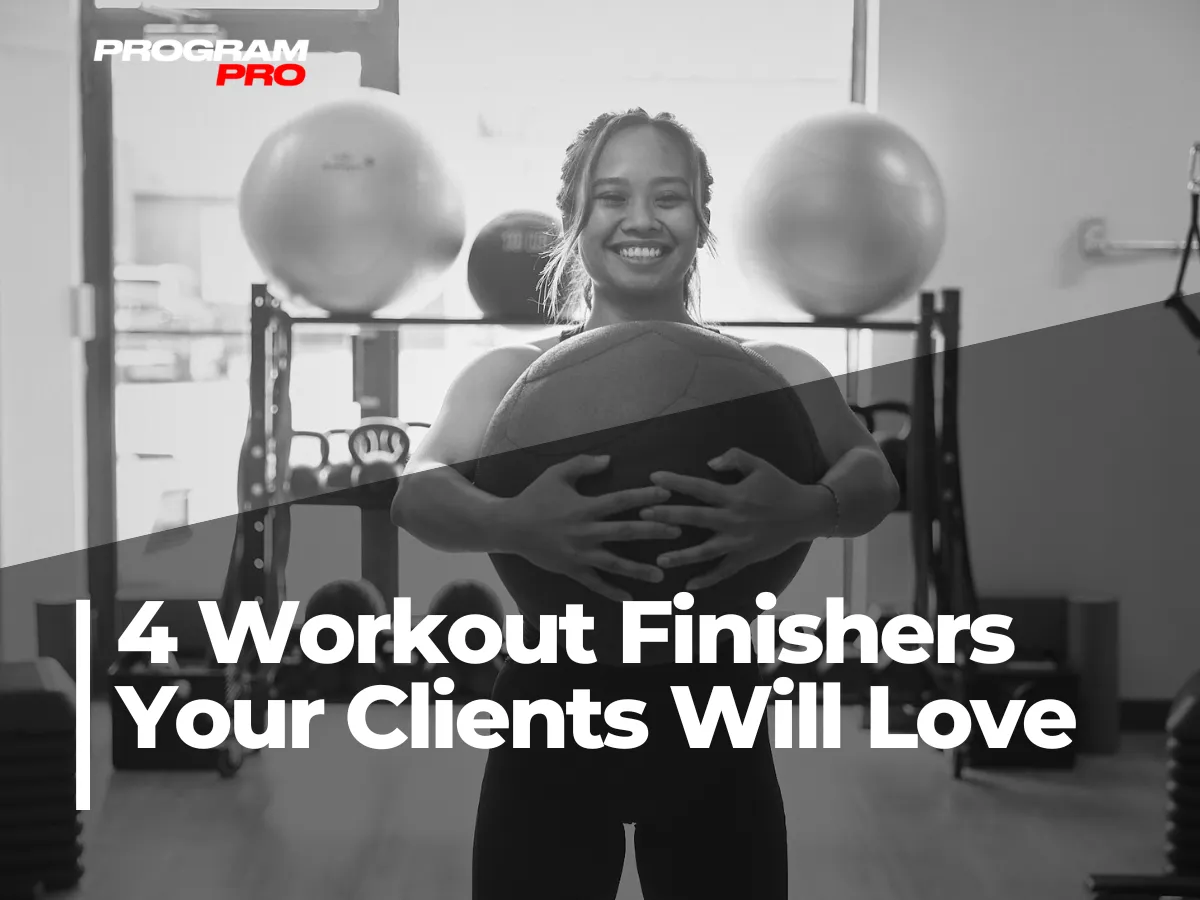
Program Pro Blog

Finish Strong: 4 Workout Finishers Your Clients Will Love
Finishers are a great way to end your workouts for a few reasons.
First, they wrap up the session on a high note. Your clients leave the gym feeling accomplished, energized, and like they’ve taken one more step toward achieving their goals.
Second, finishers offer a powerful team-building element. If you train clients in groups—whether it’s small group personal training or semi-private sessions—working toward a shared goal can really help build community. That sense of camaraderie works wonders for both client retention and motivation.
Third, from a fat loss perspective, finishers trigger what's called EPOC—excess post-exercise oxygen consumption. Finishing the session with high-intensity work kicks your body into overdrive to repair itself after the workout, leading to a higher calorie burn throughout the day.
Keep It Simple
I used to overthink exercise selection for finishers, but I’ve learned to keep it simple. Choose exercises your clients can perform safely and effectively with little to no coaching. That means movements they’re already familiar with—ones they can jump into without needing a technique breakdown.
Align with Client Goals
Your finishers should also match your client’s goals. If the last thing they do in a session feels directly aligned with what they’re working toward, it leaves them feeling empowered—and more likely to come back.
Give Clients Autonomy
Give your clients some choice. One of the best aspects of finishers is their flexibility. Let clients have a say in which exercises they do. This keeps things engaging and personalized.
Go-To Finisher Exercises
Some of my favorite finisher tools are:
Assault bike
Sled or prowler pushes
Kettlebell swings
Medicine ball slams
These are simple, scalable, and self-limiting—clients can push themselves as hard as they want.
On the flip side, I usually avoid things like box jumps, Olympic lifts, or heavy overhead barbell lifts. These are technical movements requiring precise form and coaching. When clients are fatigued at the end of a session, form tends to break down—and that’s where injuries happen.
4 Finisher Templates I Use in My Programming
Here are four reliable finisher structures I use regularly, especially in my small group personal training program:
1. Pyramid Sets
A pyramid set involves 1–3 exercises, with the reps starting high and dropping lower each round.
Example A – Assault Bike & Med Ball Slams
Assault bike: 10 calories
Med ball slams: 10 reps
Then repeat for 8, 6, 4, and 2 calories/reps.
There's no set rest, so I’ll usually time clients on this and have them try to beat their score weekly using the same rep scheme.
Example B – Sled Push Drop Set
40 yards sled push at 2x bodyweight
Drop to 1.5x bodyweight
Drop to 1x bodyweight
Finish with 0.5x bodyweight
This is technically more of a drop set based on load, but it follows the pyramid structure and can be incredibly effective for both strength and conditioning.
2. AMRAP (As Many Rounds/Reps As Possible)
I’ll typically carve out 2–4 exercises and cap these at 5–10 minutes. They can be:
Conditioning-based (high intensity)
Metabolic/pump-based (muscle burnout)
Example A – Team Sled Push
Two lines of clients on each side of the turf. Client A pushes the sled 10 yards to the other line, trades spots, and the next person pushes it back. The team pushes back and forth as many times as possible in a set time. Great for team spirit and high effort.
Depending on who I'm training, I'll usually have 90lbs (two 45lbs plates) on the sled for this one.
Example B – Full-Body Conditioning
10 kettlebell swings (20-25% bodyweight)
10-calorie assault bike
10 medicine ball slams
10-minute AMRAP. Record rounds completed, and aim to beat it next week.
Example C – Upper Body Burnout
10 close-grip push-ups
10 hammer curls
10 band pull-aparts
Set an 8-minute cap and go for as many quality rounds as possible. Great upper body finisher.
3. Explosive Repeats
High-intensity bursts with longer rest periods. Common work/rest ratios I use are 10/50, 12/50, 12/45, or 15/45 seconds.
To increase volume, add more rounds week by week. To increase intensity, increase the work duration or reduce rest.
Example – 4-Exercise Circuit
Assault bike
High knees
Medicine ball slams
Lateral slides or sled push
Each: 12 seconds of work, 50 seconds rest. Repeat the full circuit for 2 rounds.
Progression Model:
Week 1: 10/50
Week 2: 12/50
Week 3: 12/45
Week 4: 15/45
Bonus Variation – EMOM (Every Minute on the Minute):
One of my clients is a professional boxer. Here's an EMOM we used for conditioning during her training camp.
Set a timer. At the top of each minute, start a new set. The faster you finish, the more rest you get.
Example:
Minute 1: Sled push 20 yards down and back
Remaining time: Shadowbox for active recovery
Repeat for 10–12 rounds
Focus here is on power endurance and sustained output.
4. RFT (Rounds for Time)
This is the opposite of AMRAP. Instead of a time cap, you predetermine the reps/sets and record how fast you can complete it. Then try to beat your time week to week.
Example A – “Filthy 50” Glute Finisher
50 lateral shuffles (each direction)
50 hip thrusts with a hip circle
50 banded adductions
50 banded air squats
All glute-focused with constant tension from the band. Great burnout at the end of a leg day.
Example B – Full-Body Conditioning
50 push-ups
40 kettlebell swings
30-calorie assault bike
20 squat jumps
10 med ball slams
Break into as many sets as needed, but aim to finish as quickly as possible with good form. Record your time and try to beat it in the next session.
Thanks for reading. I’ll see you in the next one.
Use Templates to Design Better Programs in Less Time
Programming is an essential skill for trainers. Without it you won't get results, referrals, or a reputation as the go-to trainer. Which is why I built the Program Pro Certification.
When it comes to programming - success leaves clues.
And templates allow you to build off of past successes.
Learn how to design better training programs in less time with my FREE 12-Week Plug and Play Program Template. Just enter your name and email for instant access.


